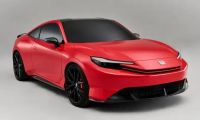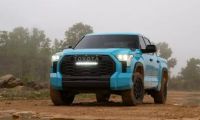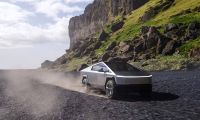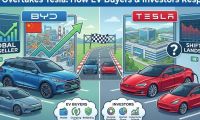It’s quite easy to see why. When the safety group put seven crossovers through its proposed small right-front overlap crash test – the proposed addition to test program – it found that Toyota’s RAV4 and Nissan’s Rogue were unsafe, especially at 40 mph, the speed at which the test occurred. Each of the crossovers performed nicely in the small left-front overlap crash test, but under the proposed change, well, here’s what IIHS has to say:
“If the Institute issued ratings for passenger-side protection the RAV4 would earn a poor rating. The Rogue would earn a marginal … These two vehicles had the highest amount of passenger-side intrusion. Intrusion measures are important because they indicate how well the structure held up; the greater the amount of intrusion, the higher the likelihood of serious injuries. Maximum instrusion in the passenger-side test was 13 inches more than in the driver-side test for the RAV4 and 10 inches more for the Rogue. The Rogue’s door hinge pillar tore off completely, and the RAV4’s door opened In a real crash, an open door would leave the occupant at risk for ejection.”
That’s quite an indictment of each vehicle. It’s warranted, though says Becky Mueller, an IIHS senior research engineer and lead author of the study that identified the weakness. “This is an important aspect of occupant protection that needs more attention. More than 1,600 right-hand front passengers died in frontal crashes in 2014.”
It’s a standard that automakers should honestly routinely meet. It’s just that some automakers, once they have a design down, don’t want to make changes, even if they enhance safety. If they had done the design process right in the first place, there wouldn’t be an issue. It is plain to see this is true when you consider that Hyundai achieved a “good” score in both the current test (small left-front overlap crash test) and the proposed right-front test. (See how surprising is the 2016 Hyundai Tucson in many ways in this review by TorqueNews managing editor Patrick Rall).
Admittedly, small overlap tests are particularly challenging for automakers because they bypass a vehicle’s main front structure. Before the safety group added the small left-front overlap test in 2012, vehicle test results were similarly poor. However, once added, the industry responded with changes and the driver’s seat became a safer place. The adoption of the small left-front test did not occur overnight. A moderate overlap test, covering 40 percent of the front end width, was added in 2002, while it took a decade to add the small left-front overlap change. The small left-front overlap involves 25 percent of the vehicle’s width. The test is designed to show what happens when the front corner of a vehicle hits another vehicle or strikes an object like a tree or pole.
The small front overlap test became a catalyst for change as 13 manufacturers have made structural changes to nearly 100 vehicles to meet the test’s requirements. The resulting changes yielded good ratings for three-quarters of the vehicles after the changes were made.
Also See: 12 Things Good and Bad About the Hyundai Tucson FCV
The small left-front overlap test was a natural outgrowth of the moderate overlap test. That both tests were aimed at the driver’s side was a simple expedient, the safety group assumed that every car on the road has a driver, but not that every vehicle has a front-seat passenger riding along.
“It’s not surprising that automakers would focus their initial efforts to improve small overlap protection on the side of the vehicle that we conduct tests on,” David Zuby, IIHS executive vice president and chief research officer, said in a statement. “In fact, we encouraged them to do that in the short term if it meant that they could quickly make driver-side improvements to more vehicles. As time goes by, though, we should hope they ensure similar levels of protection on both sides.”
The recent passenger-side tests illustrate how wide the gap in frontal protection can be. Most of the vehicles performed poorly when they were crashed into the barrier on the right front. “When structural improvements are visible only on the driver-side, there are large differences in performance,” IIHS’ Mueller says. “But the inverse is not true. Some vehicle structures look the same on both sides, but they don’t perform the same. That’s why we can’t rely on visual analysis but need to monitor this issue and possibly begin rating vehicles for passenger-side protection.”
And, this leads us to the situation uncovered by the small right-front overlap study, “Comparison of vehicle structure and occupant responses in driver- and passenger-side IIHS small overlap frontal crash test.” Hyundai’s Tucson is the strongest model of the seven crossovers tested. The far smaller Korean manufacturer has beaten General Motors, Honda, Mazda, Nissan and Subaru to come out on top.












